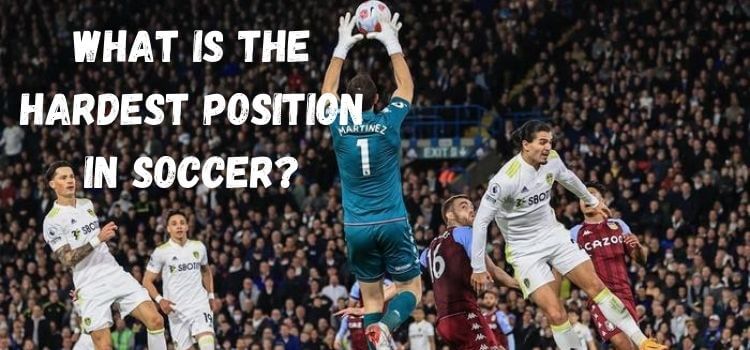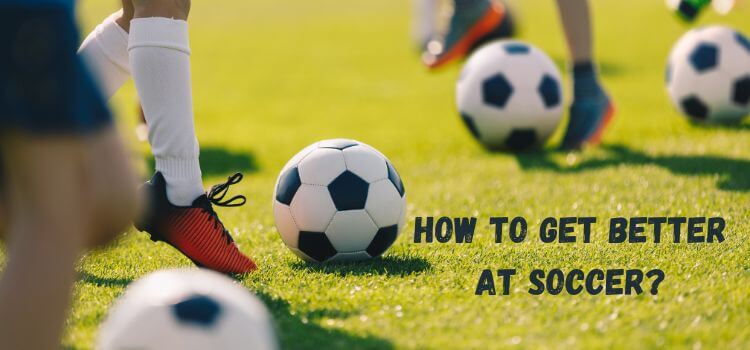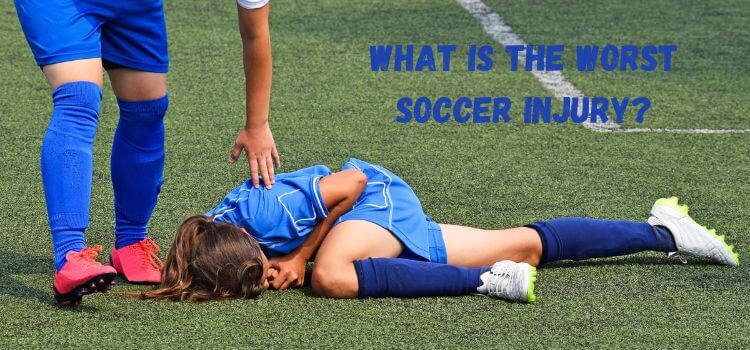As an Amazon Associate, I earn from qualifying purchases
Soccer, also known as football in many parts of the world, is a game loved by millions. It’s a sport that requires a unique blend of physical prowess, tactical understanding, and mental fortitude. Each position on the soccer field comes with its own set of responsibilities and challenges, making the game as intricate as it is exciting. But among these, which position is the hardest to play in soccer? Let’s dive into the roles and demands of each position in soccer to uncover this mystery.

Goalkeeper
Role and Responsibilities
The goalkeeper is the last line of defense and the first point of attack. Their primary job is to prevent the opposition from scoring by making saves, catching crosses, and organizing the defense.
Fast reflexes, superb hand-eye coordination, and game-reading abilities are all necessary for this function.
Physical and Mental Demands
Being a goalkeeper is incredibly demanding, both physically and mentally. Physically, they must be agile, strong, and have exceptional jumping ability.
Mentally, goalkeepers must stay focused for the entire match, as a single mistake can cost the team dearly. The pressure on goalkeepers is immense because their errors are often the most noticeable.
Famous Goalkeepers
Legends like Lev Yashin, Gianluigi Buffon, and Manuel Neuer have showcased the importance and difficulty of this position through their incredible careers.
Their ability to perform under pressure and make crucial saves has earned them accolades and admiration worldwide.
Center-Back
Role in Defense
Center-backs are the backbone of any defense. Their primary responsibility is stopping opposing attackers, intercepting passes, and winning aerial duels. They also play a crucial role in building play from the back, often starting the team’s attacks with their passing.
Key Skills Required
Strong tackling skills, positional awareness, and the capacity to read the game are essential for a center-back. Communication is also crucial, as they need to organize the defense and work closely with the goalkeeper.
Challenges Faced
The biggest challenge for center-backs is dealing with fast and skilled attackers. When forced out of position, they must be able to correct themselves and make snap decisions quickly. The physical battles with strikers also take a toll, requiring peak physical condition.
Full-Back
Duties on the Field
Full-backs have a dual role of defending against wingers and supporting their own team’s attacks. They must be able to track back quickly and provide width in offensive plays, often overlapping with wingers to deliver crosses.
Physical Endurance Needed
This position demands incredible stamina. Full-backs are among the players who cover the most ground in a match, constantly running up and down the flanks. They need to be fast, agile and have excellent crossing abilities.
Balancing Offense and Defense
Finding the ideal mix between attacking and defensive responsibilities is one of the biggest problems facing full-backs. They must be able to switch roles seamlessly, ensuring they do not leave their defensive line exposed while supporting attacks.
Defensive Midfielder
Shielding the Defense
In front of the defense, defensive midfielders operate as a shield, stopping enemy attacks and covering the back line. They are often the unsung heroes, doing the dirty work that allows more creative players to shine.
Tactical Awareness
Defense midfielders must be highly knowledgeable about the game to play this position since they must read their opponents’ movements and adjust their positioning. Their ability to intercept passes and tackle effectively is crucial.
Transition Play
Defensive midfielders are also vital in transitioning from defense to attack. They need to distribute the ball accurately and make intelligent decisions under pressure, often setting the tempo for the team.
Central Midfielder
Playmaking Abilities
Central midfielders are the team’s engine room. They are involved in almost every game aspect, from defense to attack. Their primary responsibilities are to pass the ball, set the pace, and open doors for their teammates.
Box-to-Box Role
Many central midfielders are known as box-to-box players because they contribute at both ends of the pitch. This requires immense stamina and the ability to read the game well.
Decision-Making Under Pressure
Central midfielders often have to make quick decisions while under pressure from opponents. Their ability to retain possession and find key passes can dictate the outcome of a match.
Attacking Midfielder
Creative Responsibilities
Attacking midfielders are the creative hub of the team. They operate in the space between the opposition’s defense and midfield, looking to create scoring opportunities through dribbling, passing, and shooting.
Vision and Passing Accuracy
A good attacking midfielder needs excellent vision and passing accuracy. They must be able to pick out runs from their forwards and deliver precise passes, often in tight spaces.
Impact on the Game
Their ability to change the game with a single pass or moment of brilliance makes attacking midfielders crucial to any team’s success. They often contribute to both goals and assists.
Winger
Speed and Dribbling
Wingers are typically among the fastest players on the pitch. They stretch the opposition’s defense by staying wide and using their speed and dribbling skills to beat defenders.
Crossing and Shooting
Apart from generating opportunities via crosses, wingers should also cut inside and attempt goals. Their ability to switch between these roles makes them versatile attackers.
Defensive Contributions
Modern wingers must also track back and help their full-backs in defense. This adds to their workload and demands high levels of fitness and discipline.
Forward/Striker
Scoring Goals
The primary job of a forward or striker is to score goals. They are the focal point of the attack and must be clinical in front of the goal.
Positioning and Movement
Strikers need excellent positioning and movement to find spaces in the opposition defense. Their ability to read the game and anticipate where the ball will be is crucial.
Handling Pressure
Forwards are often under immense pressure to deliver goals. One of their strongest suits is their capacity to remain serene and calm under duress.
Comparison of Positions
Different Skills Required
Each position in soccer requires a unique set of skills. While goalkeepers need reflexes and mental toughness, outfield players require stamina, technical ability, and tactical awareness.
Physical vs. Mental Challenges
Some positions, like the center-back and defensive midfielder, are more physically demanding due to the constant battles with opponents. Others require continuous focus and decision-making, such as the attacking midfielder and goalkeeper, which can be mentally exhausting.
Factors Making a Position Hard in Soccer
Physical Demands
Physically demanding positions include center midfielder and full-back since they involve a lot of running. These players must be in peak physical condition to maintain their performance throughout the match.
Tactical Complexity
Roles like the defensive and attacking midfielder require a deep understanding of the game. These players must be able to read the game and make tactical decisions quickly.
Psychological Pressure
Goalkeepers and strikers often face the most psychological pressure. A single mistake by a goalkeeper can lead to a goal, while strikers are under constant pressure to score.
Expert Opinions
Views from Coaches and Players
Many coaches and players have weighed in on this debate. Some argue that goalkeepers have the most challenging job due to the high stakes of their position, while others believe that central midfielders face the most formidable challenge due to their all-encompassing role.
Statistical Analysis
Statistics can also provide insight into the most challenging positions. For example, goalkeepers often have the longest careers, suggesting that their role, while mentally taxing, might be less physically demanding in the long term.
Training and Preparation
Position-Specific Drills
Training for each position involves specific drills. Goalkeepers work on reflexes and diving, while midfielders focus on passing and movement. Strikers practice finishing, and defenders work on tackling and positioning.
Mental Conditioning
Mental conditioning is crucial for all positions but is especially important for goalkeepers and strikers. Visualization techniques and psychological training can help these players handle pressure better.
Common Injuries by Position
Injury-Prone Roles
Certain positions are more prone to injuries. For example, full-backs and wingers, who do many running and sharp turns, often suffer from muscle strains. Center-backs are prone to injuries from physical clashes.
Preventive Measures
Preventive measures, such as proper warm-ups, strength training, and flexibility exercises, are essential to minimize the risk of injuries. Teams also invest in sports science to monitor players’ fitness levels and prevent overtraining.
Conclusion
In conclusion, determining the hardest position in soccer depends on various factors, including physical demands, tactical complexity, and psychological pressure. While each position presents challenges, the goalkeeper stands out due to the unique physical and mental needs blend. However, every role is vital to a team’s success, and the hardest position in soccer comes down to personal perspective and playing style.
FAQs
The goalkeeper position is unique because it combines physical agility with intense mental focus. Goalkeepers are the only players allowed to use their hands, and their mistakes are often the most costly.
Due to their dual role in attack and defense, central midfielders are called the “engine.” They cover the most ground, control the game’s tempo, and are essential in transitioning the play.
Full-backs are the most adaptable because they have to balance assisting the attack and playing defense. They often overlap with wingers and contribute to both ends of the pitch.
Professional players often decide their best position in soccer based on their skills, physical attributes, and playing style. Coaches also play a significant role in identifying and nurturing a player’s strengths.
Coaching is crucial in mastering a position. Coaches provide the necessary training, tactical understanding, and mental conditioning for players to excel in their roles.
Read Our More Articles
- How Can You Join a Soccer Club with No Experience?
- De Leon Soccer Complex McAllen: A Soccer Paradise
- The May Soccer Complex Exploring: A Soccer Lover’s Paradise
As an Amazon Associate, I earn from qualifying purchases


